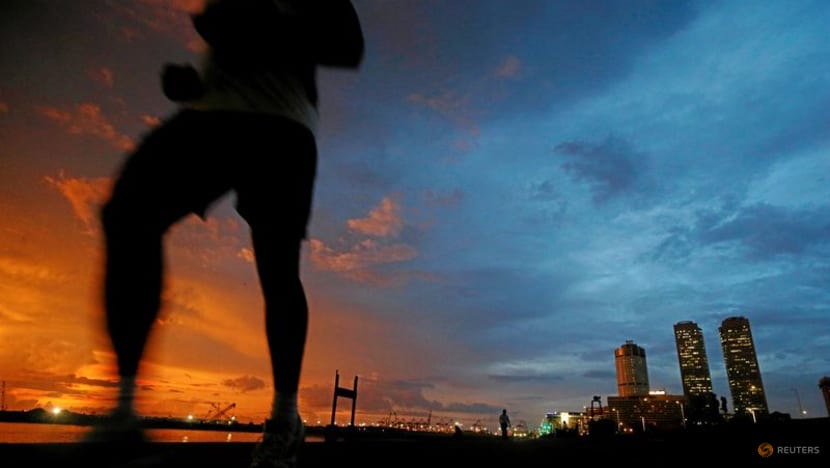Sri Lanka’s Foreign Minister hails Chinese investment, dismisses notion of ‘debt-trap diplomacy’
Foreign Minister Ali Sabry said the biggest lesson from the country’s worst economic crisis last year was having fiscal discipline and consistent monetary policy.

FILE PHOTO: Financial district of Colombo is seen as a man runs along a path in front of the China invested Colombo Port City construction site in Colombo, Sri Lanka November 22, 2017. REUTERS/Dinuka Liyanawatte/File Photo
SRI LANKA: As Sri Lanka continues to struggle to emerge from its worst economic crisis and political turmoil in decades, Foreign Minister Ali Sabry said that China’s investment remains important.
The biggest lesson is fiscal discipline and consistent monetary policy which is pragmatic and consistent with international best practices, he told CNA in an interview in July.
“We have learned a lot (from) that. You can't continue to maintain a welfare state without having a steady revenue stream. That means fiscal discipline,” he said.
Sri Lanka is working to restructure about US$83 billion in debt, both domestic and external.
The country’s economy shrank 3.1 per cent in the April to June quarter, an improvement over the first three months of the year, when it contracted 11.5 per cent.
Activity gradually stabilised after the government managed to secure a US$2.9 billion bailout from the International Monetary Fund (IMF) in March.
INVESTMENTS FROM CHINA
Among the factors that led to the crisis was the country’s difficulties in managing its external debt, which had grown in part due to loans from China to fund ambitious infrastructure projects.
When asked about China’s relationship with Sri Lanka in its time of crisis, Mr Sabry said: “China's investment is very, very important because countries like Sri Lanka need investment.”
He noted that the Chinese helped after the civil war in Sri Lanka ended in 2009 and the country was in need of massive investment.
“We didn’t only invite the Chinese. We made it open to the whole world. So some of the other countries wanted to wait and see. But China took the risk (and) invested,” he said.
He added that the next phase of Sri Lanka’s development is about growth, which requires more investment.
“Among the major players right now in the world, China has a hefty pocket. They are waiting (to invest). We are part of the BRI (Belt and Road Initiative). So, for us, Chinese investments are important and we look forward to it,” he said.
Over the last decade, China has channelled about US$3 billion into Sri Lanka, accounting for nearly a quarter of its foreign direct investments.
DEBT-TRAP DIPLOMACY?
When asked whether he had concerns on the BRI being used as a tool to create debt traps for its recipient countries - a common criticism of the mega infrastructure project - Mr Sabry dismissed the notion.
“I don't think so. What are they going to achieve out of the debt trap? If you put your money into any country for investment, it obviously (means) they want returns. So if you want returns, you want to see that that country succeeds,” he said.
He turned the attention inwards instead, saying that Sri Lanka has gone wrong in identifying areas to prioritise its investments in some instances. In hindsight, it is important that the manufacturing sector supported the growing infrastructure, he said.
“Industries must come up so that these infrastructure could support that process. Unfortunately, that process has not taken place in Sri Lanka,” he said.
That is why it is important for Sri Lanka to make the right call in investment decisions moving forward, he said.
“Sri Lanka is very, very clear right now. We will no longer go and borrow money. What we are asking is for investment, partnership, opportunities to grow together. So, I think we have learned that lesson during the last year because of this crisis."
China has invested in multi-million-dollar projects touted to boost the country’s economic growth. For instance, the Chinese-funded Mattala Rajapaksa International Airport under the BRI drive was to be the country’s number two air transport hub. But ten years on, it is widely considered to be a commercial failure.
The southern Hambantota Port became another case in point - it led the country to be labelled a poster child for the so-called Chinese debt trap narrative after a Chinese state-owned operator took control of the port on a 99-year lease after Sri Lanka defaulted on its loans.
However, like Mr Sabry, some analysts have also dismissed the so-called debt trap diplomacy.
Chairman of policy think tank Advocata Institute Murtaza Jafferjee said: "It's not a debt trap of China's creation. But our debt issues, because out of our total debt, about 55 per cent of it is domestic debt.”
The rest is external debt, he said, adding that it is estimated that the country's public sector debt is 128 per cent of Gross Domestic Product (GDP), one of the highest for a middle-income country.
While the jury remains out on whether Chinese money is more of a boon or bane, Sri Lanka has attracted outsized attention not just from China, but also from India and the United States, given its strategic location in the Indian Ocean.
In response to whether Sri Lanka appears to be caught up in a big power play, Mr Sabry said that the country stands in the middle and does not take sides.
“We don't want tension with anyone. We will not allow anyone to use our backyard to threaten any other country or to build their military bases, that's for sure. But we have a strategic relationship with all of them,” he said.


















